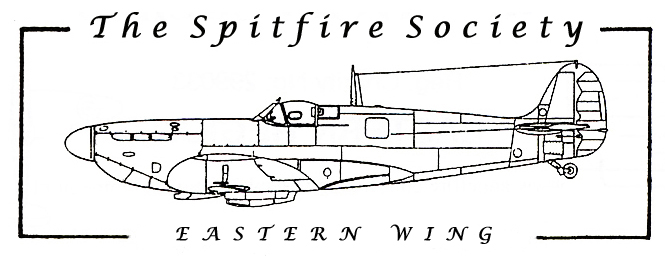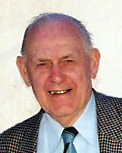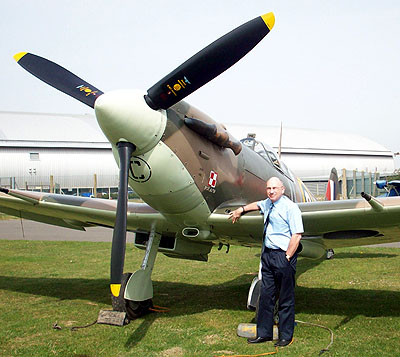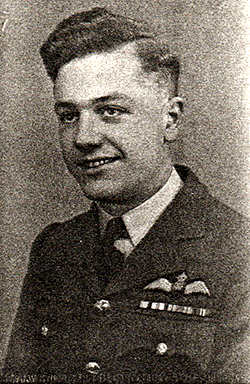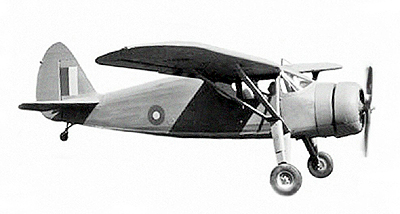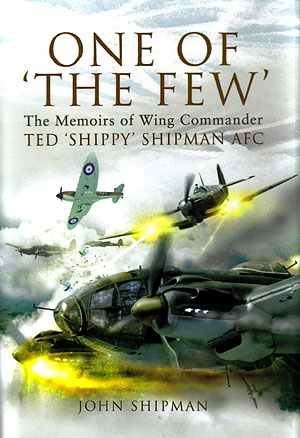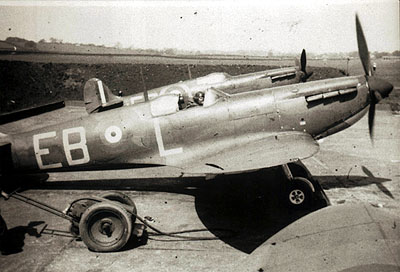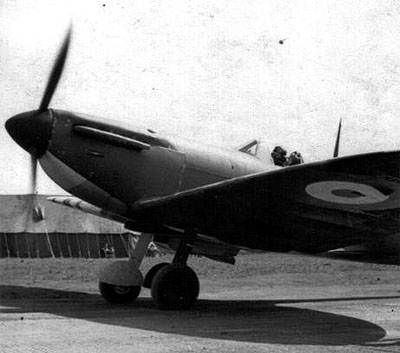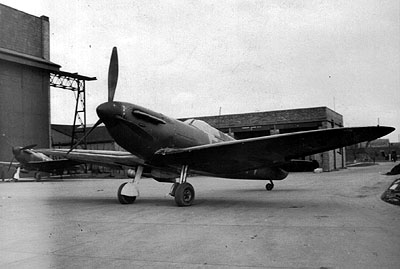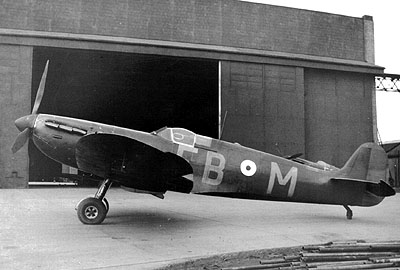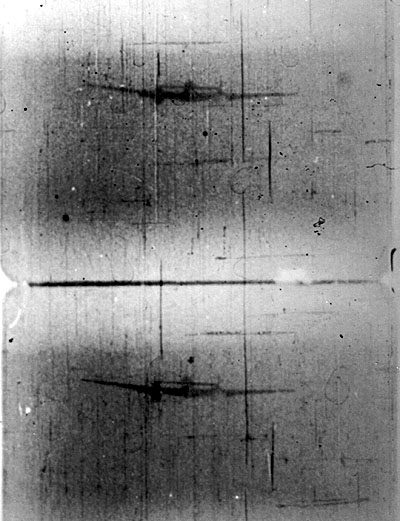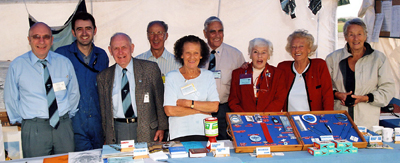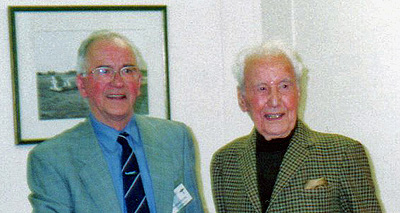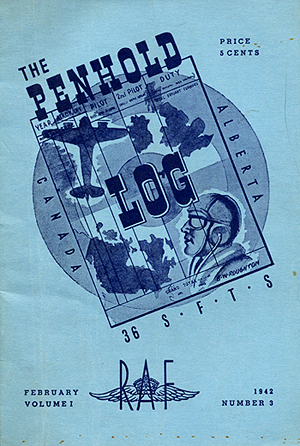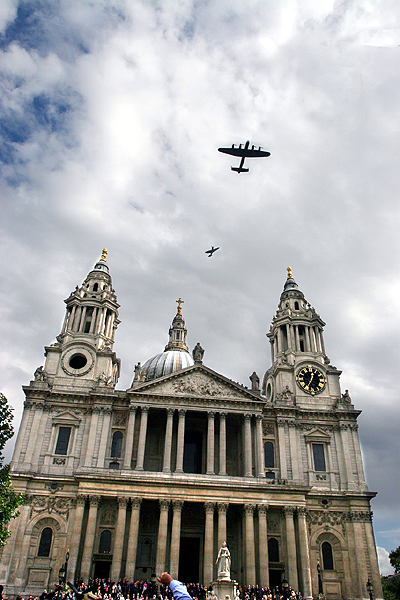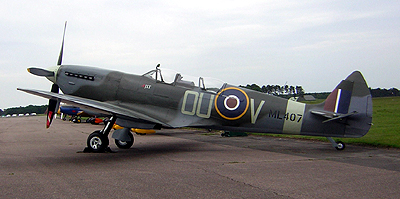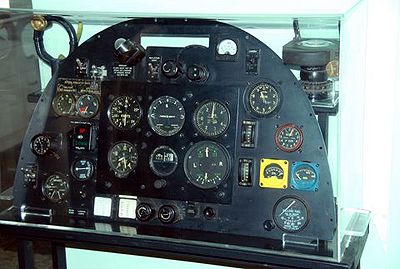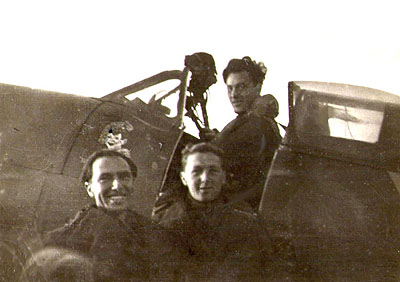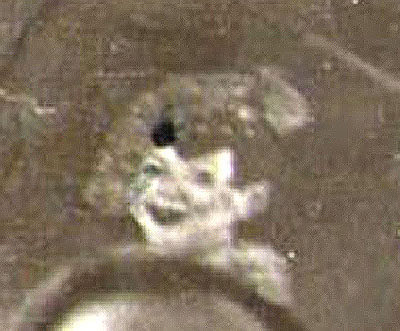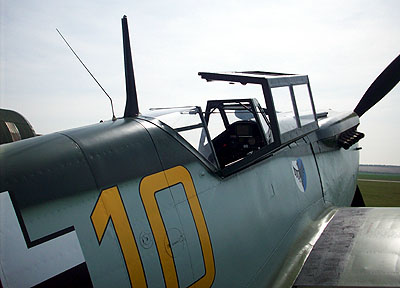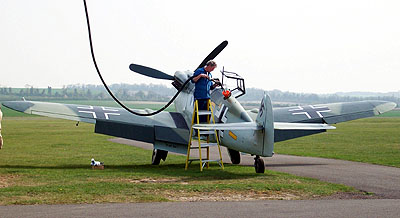 Home Page
Pat Butler
|
INDEX
A Ferry Story Part II
How to Fly a Bomber in Two Lessons
Commemoration of The Battle of Britain
---------- Here we are at
the start of another New Year and we do so with great optimism
for 2011. We have enjoyed
a very successful year in many ways; the air shows at Duxford
were fruitful and the sun shone on us for most of the time. We
had the pleasure of many new people becoming members. It was
also the best year ever for new volunteers at the Stand and I
thank them all. Due to failing
eyesight I have had to stand down as your Treasurer. I would
like to say thanks to all the Committee and Helpers past and
present who have given me such great support over the last
sixteen or so years; many, many thanks. Sadly, we mourn
the loss of Audrey Horwood, Norman Lyons and Pam Gould. We will
always remember them. I would finally
appeal to anyone who would like to join our Committee to contact
our Secretary Gerard Crutchley or myself. I wish you all a
very healthy and happy New Year.
David
----------------------------------- Welcome to Form 700 After many years
of service, one of the longest serving members of the Eastern
Wing (and former Eastern Region) committee, Steve Beale, has
decided the time has come to step down. As our Wing Secretary
Steve has performed outstanding work in keeping the affairs of
the region running smoothly and his will be a hard loss to bear,
though it is no exaggeration to say that if anyone has earned a
rest (if indeed ‘Rest’ it may be called, for I know that Steve
always has plenty to keep him busy at home!) then that person is
Steve. The great news is that he has elected to continue as one
of our key workers on the air show sales stand, a task which he
has performed in tandem with his committee duties, helping to
raise a great deal of money for the Spitfire Society. For
deciding to stay on in that most vital capacity and for all of
the years of work that he has dedicated to our society in his
various roles we would, on behalf of the Committee and Regional
Members like to express our thanks to Steve and wish him and
Carol all the very best for the future.
Further losses
to the wing came last year with the passing of three of our most
loved and respected members, Audrey Horwood, Norman Lyons and
Pam Gould. Audrey was a loyal, enthusiastic and hardworking
member of our team of helpers; a short piece about her work may
be found inside this magazine. Norman, a wartime pilot, was a
founder-member of the former Eastern Region and dedicated many
years to working on the regional committee and our sales stand.
Pam Gould was a dear friend to this region and a great support
to husband Ron during his many years service on our committee.
Amongst other things Pam helped organise the Old Warden Members
Days that we used to share with the Arnold Scheme Stearman
Association, and together with Audrey and Norman will be greatly
missed. With Steve Beale
exiting the Committee there was a worrying moment when we feared
for our future minus such a vital component. Cometh the Hour,
Cometh the Man and along with his numerous other duties which
include managing the website and, fundraising at air shows and
overseeing the publication of this newsletter, Gerard Crutchley
has volunteered to step into the breach and take up the baton of
Wing Secretary. Gerry is undoubtedly one of the hardest working
members of the Spitfire Society – how he manages to spin so many
plates for us whilst managing what I know to be a very busy
private life is quite astonishing, but I am sure that we are all
glad that he does; Thank You Gerry, and best wishes in your new
role. For the last few
years Jason Amiss has been handling the business affairs of our
society Spitfire Enterprises. This work has now been
taken over by HQ, and so Jason is stepping down from his role.
Jason, assisted by his Aunt Paula and our own David Williams,
has done an absolutely splendid job in a role which has occupied
a great deal of his time and energy, and which has undoubtedly
garnered a great deal of income for us. The good news is that
Jason will be continuing his work on our committee, but in
respect of Spitfire Enterprises we would like to offer Jason
many thanks indeed for all of your hard work. In other news,
as is our custom a wreath was laid on behalf of the Spitfire
Society by Sqn Ldr Ian Blair DFM at the Cross of Sacrifice, St.
Andrews Church North Weald on Sunday 12th September
at a service commemorating the seventieth anniversary of the
Battle of Britain. The Minister for the occasion was The
Reverend Rayner Harries MBE, former Assistant Chaplain-in-Chief
of the Royal Air Force. Sqn Ldr Blair also laid a wreath for us
at the annual Remembrance Day ceremony at the Airfield Memorial
adjacent to North Weald Museum. This year’s
Committee and Helpers Christmas Lunch was again a great success,
once more being held at The Squadron, North Weald. We were once
again privileged to have as our Guest of Honour Wing Commander
Peter Ayerst DFC who very kindly gave us a riveting talk on his
time during the Battle of France which everybody enjoyed
enormously – many thanks indeed Peter. A notable feature of this
year’s lunch was that it coincided very closely with the 90th
birthday of our Chairman David Williams. Eric Horwood provided a
beautiful cake and gave a heartfelt speech which echoed the
sentiments of those present; many people have over the years
been cited as the ‘Saviours’ of the Spitfire Society and the
truth is more likely that without the support of its members the
society would probably have perished long ago. But few would
deny the importance that Eastern Region has played in keeping
the whole thing airborne and that having taken on the job of
Chairman from the late and much missed Dennis Nichols, David
Williams has done an incredible job, frequently (and even now!)
in the face of fierce adversity and whilst balancing numerous
other jobs such as Hon. Treasurer, Sales Stand Co-ordinator,
Spitfire Enterprises official and Executive Committee member at
the same time. Surely no member of this society has ever worked
so hard or so conscientiously, and surely no member is more
deserving of our gratitude and respect. Happy Birthday David!
Stop Press! Treasurer Required! I am sorry to
report that after many years work as our Hon. Treasurer David
Williams now has to retire due to health problems. David has
always been scrupulously diligent with his book-keeping and it
has always been a hallmark of his work that all aspects of the
accounts have been fully transparent and accessible to any
member at any time. Few people could have done a better job and
we will be eternally grateful to David for all the work he has
done for us in this field. I am very pleased to confirm however
that David will continue in his other roles including that of
our Regional Committee Chairman. This loss of a
Treasurer puts us in a very serious position; incredibly, Gerard
Crutchley has stepped in to fill the position for the time
being, but with the huge amount of other work that he does for
us it would be unreasonable to expect him to continue in this
job permanently. The situation
then is that unless someone comes forward to fill this position
we will not be able to continue our work raising funds every
year at air shows (a job which I know our society’s Chairman Len
Dickson values very highly), and this in turn will lead very
quickly to the end of this Wing, at least in its present form.
So if you are an enthusiastic team player and have a basic
understanding of book-keeping or are reasonably good with
figures and feel that you may be able to help please get in
touch as soon as possible with David, Gerard, or any other
member of the Committee; the survival of our Wing may depend on
you. We would also
very much appreciate offers of help with other aspects of
committee work, such as co-ordinating the air shows and
volunteers, sales stand/stock logistics and researching/writing
articles for this Newsletter. The committee is now very thinly
stretched and the situation becoming dire; again, if you think
you may be able to help, now is the time to come forward as
tomorrow it could be too late. Diary Dates The Eastern Wing Annual
General Meeting including the Pat Butler Memorial Awards will be
held on Saturday 30th April at Old Warden. The Spitfire
Society Main AGM is to be held at Duxford on Saturday the 21st
of May, further details in the next number of the Spitfire
journal. Peter Wesson ----------------------------------- Part II Geoff Bates If you have not read Part I, you can find
it here:
By this time the
Germans and Italians had been kicked out of North Africa and
Sicily and were being pursued north in Italy. As a result it was
now possible to ship aircraft to Casablanca which meant that
little single-engined aircraft were no longer being shipped to
Takoradi. I did make Takoradi but this time as a second pilot in
a Lockheed Ventura, and then followed a posting to No.3 ADU
based at Oujda in what was then French Morocco. There we were
housed in what had been one of the bases of the Foreign Legion.
The accommodation was not quite up to the standard we had
enjoyed at No.1 ADU where we had had Italian POW’s to look after
us. Within a week of
arriving at Oudja, without notice I was told to go to Casablanca
to join a Wellington crew whose second pilot had been taken ill.
The aircraft was to be taken to Cairo; was I ever going to get
some solo flying? On arrival at Casablanca I sought out my
skipper and to my great surprise it was a fellow I had sat next
to in my fifth year at school. After four
months without any solo flying I was on orders to go to
Casablanca to collect a Spitfire for delivery to Cairo. It was a
wonder that I still knew how to fly a Spit’. I subsequently
learned that the Chief Test Pilot at Casablanca was a Flight
Lieutenant David Green, who was having a short break from
operational flying with 73 Sqn Desert Air Force; it was he who
founded The Spitfire Society. Fortunately I had remembered
enough to get airborne and so the whole convoy set course for
Oudja, our first stop. Nearing Oudja my engine lost power and I
couldn’t keep up with the others. By the time the rest of the
convoy were again ready to take off, my Spit’ was not
serviceable. I was told that if my Spit’ was made serviceable
when the next convoy came through I was to join it. This I did
and on arrival at Cairo my former convoy members were just about
to board their Dakota DC3 for the journey back to Oudja. Their
first night stop was at Biskra on the northern edge of the
Sahara desert and on the foothills of the Atlas Mountains. Next
morning they took off for Algiers. The weather briefing was that
soon after take-off they would have to climb above thick cloud
which stretched all the way to the coast. It would be safe to
let down through the cloud over the coastal strip. Allowance
would have to be made for a headwind of ‘x’ miles per hour. In
the event the wind was 3 x mph, with the result that when the
pilot let down thinking he was over the coastal strip he was in
fact still over the mountains into which he crashed killing 27
of the 28 aboard. All of my companions were killed. It was
terribly hard to believe my good
luck. The fellow who survived was in an American hospital for
some time before going back to the UK and being demobbed. He was
not one of us so I do not know what effect the crash may have
had on him in the long term. When I arrived back at base the
first person I met greeted me with “You are a lucky devil,”
(actually I think the word was “sod”!!) Accused of Murder!
One aircraft I
enjoyed flying, though it was more of a toy, was the Fairchild
Argus. They were a high wing fixed undercarriage aircraft. The
interior was like a ‘Smart Car’ with four seats; the windows
wound down and there were ashtrays. There were four Argus
aircraft to be taken to Rome. As there was little single-engine
flying at the time we were allowed to take a second pilot; what
we did was that one pilot would fly the first leg, the second
pilot the next leg and so on. The slow speed of the Argus
enabled us to have a good look at the ancient city of Carthage
where, since the French occupation of Tunisia, excavation had
led to important discoveries going back to the days of the Roman
Empire prior to the destruction by fire of the city by the Arabs
in 689 AD. Virtually the
whole trip was flown at low level except for the sea crossing
from Cape Bon to Sciacca from where we flew across Sicily to
Catania. When we landed one of our aircraft was missing! After
some time we learned that the pilot had force-landed and had
been arrested for murdering his second pilot! What had happened
was that whilst low-flying the second pilot had flopped forward
with blood gushing from the side of his neck where he had
obviously been shot from the ground. The pilot landed the
aeroplane on a road to get help. The Italian police asked the
pilot at what height he had been flying; “About fifty to a
hundred feet” the pilot had replied in his broad West Country
accent. The policeman’s English was not that good and he
interpreted this as fifty-two hundred feet, i.e. 5,200;
therefore it would have been impossible for the second pilot to
be shot from the ground, thus murder! The poor chap spent two
very uncomfortable days in a Sicilian police station before the
police could be persuaded to hand him over to the RAF until they
had completed their enquiries and decided whether or not to
charge him for murder. Needless to say the language difficulties
were eventually sorted out and the prisoner was released to go
about his normal duties.
To
be continued… ----------------------------------- A
true story by Peter
French The following piece was written by former
wartime pilot the late Peter French and originally appeared in a
magazine called ‘The Seadog’ of which Peter was Editor. A
Seadog, as we all know, is a type of small, centre-cockpit
ketch-rigged motor/sailing boat and Peter was an enthusiastic
owner and sailor of one of these handsome vessels. Our thanks to
Mrs French for forwarding the article to us and for kindly
granting permission for its reproduction here in the Form 700. It was wartime,
and all around the world momentous events were changing the
course of history. I was then an experienced pilot in the Royal
Air Force (having entered the Service a year or so before the
outbreak of hostilities), and was stationed at an aerodrome on
the wintry Vale of York in the bleak northeast of England. On 16 January
1944, I prepared to make a routine flight to carry passengers to
St Eval in Cornwall, some 300 miles away. Our aircraft, an
elderly Airspeed Oxford, was a versatile, twin-engined
training-cum-transport monoplane of medium size. Built largely
of wood, it was noisy, and a pig to fly on one engine, but
reliable and fairly fast. Significantly, she was also fitted
with Lorenz Blind Approach Radio to facilitate landing in
conditions of poor visibility. The day of
departure dawned fine, with unbroken sunshine which soon burned
off the last remains of the overnight fog. By mid-morning
conditions were as near perfect as could be for the flight. Then, just
minutes before take-off, the port engine began to leak oil. This
was a serious set-back, made worse by the fact there was no
standby aircraft, and we had to wait for our machine to be
repaired. As precious minutes ticked away, my impatience
mounted, for I knew that any delay in take-off would have
serious consequences, for the fog was sure to return later that
day. The telephone rang. St Eval
was now fog-bound. I was advised to fly to Weston-Super-Mare,
some twenty miles to the southwest of Bristol, instead. While hurrying
to chase up the repair, I caught sight of another Airspeed
Oxford. This was the personal aircraft of the Air Officer
Commanding, the most senior of our officers. Nodding towards the
immaculate aircraft I said, half jokingly, to the Sergeant in
charge of the ground crew, “How about if I took that one
instead?” Back came an equally jocular “Why not? He's away on
leave - he'll never know!” By now consumed with impatience to be
on my way, I rashly decided to chance it. The sacred
aircraft was wheeled out of the hangar, engines were started,
run up and tested, and I signed the Serviceability Certificate,
making me solely responsible for the aircraft, its passengers,
and my own neck. I picked up my
passengers. Then, heedless of the consequences, I opened the
throttles and roared off down the runway. We made a fast
flight, with no trace of the forecast fog, and landed at
Weston-Super-Mare aerodrome in warm sunshine. I had planned an
immediate return to Yorkshire, but the summer-like weather,
together with the fact that I now felt quite hungry, overcame my
better judgement. I left the aircraft in the care of a ground
party and went for lunch. My second
mistake of the day. Before departing
I checked the latest weather report - thick fog was now forecast
for the entire country. I took off in haste and set course for
Yorkshire. By the time I had reached the Midlands, barely midway
to my destination, mile upon mile of dense fog blanketed the
ground, glowing pink in the light of the setting sun. Not even
the sight of this dented my confidence in my ability to handle
the situation - with the comforting thought that the Lorenz
Radio Beam would keep me out of trouble - I flew on. It was not until
I drew near my home aerodrome that I became conscious that all
was not well with the Lorenz. The signals in my earphones grew
weaker and weaker, then faded into mind-numbing silence. Cockpit
instruments revealed no reason for the failure. Dumbfounded at
the loss of my lifeline, I sent out a call to base - there was
no reply. I was now in
serious trouble - thousands of feet above the fog-covered Yorkshire Wolds,
late on a winter's day, aboard an aircraft with no working radio
aids, less than an hour of daylight left, and not a lot of fuel
in the tanks. Only a madman would have attempted to land in that
fog. It seemed there was no alternative - I should have to
bale-out. Simple in theory
- fly towards the coast, point the aircraft out to sea, engage
auto-pilot, then jump - and possibly end up in the fog beneath
being impaled on a church spire, incinerated among electricity
cables, or maybe drowned in a river. My mind searched
desperately for some other way to escape the dangers now before
me. Thick fog, no
wind, and no gaps in the fog. Lessons in meteorology learned
long ago flickered through my mind. Then sprang the germ of an
idea. Might it be possible that air currents generated by the
difference in temperature between the cold land and the
relatively warmer sea, could have created holes in the surface
of the fog? Perhaps if I were to fly immediately to the nearest
coastline, some 60 miles away, I might be fortunate enough find
such a hole. I glanced at my watch, checked the fuel gauges and
looked at the sun, now low in the sky. There was just time to
test my theory before approaching darkness drew the final
curtain. The sun was still shining brightly at the height at
which I was flying, but I knew that down at ground level it
would soon be dusk. Grimly aware that my fate would be decided
within the hour, I altered course and set off with all speed for
the coast. The sun was just
scraping the western horizon when some miles ahead I saw,
staining the white quilt of fog that covered the ground, a
darker patch with a ragged outline. With rising hope, I dived
headlong towards the middle of the dark patch and peered
downwards - and there, to my immense relief, I saw the black
waters of the North Sea. There was no
turning back. I screwed up my courage, put the aircraft into a
steep bank, spiralled tightly downwards through the tiny gap in
the fog, and flattened out just above the waves. Then I saw I
was flying straight towards an unbroken wall of towering white
cliffs. Adrenalin kicked
in - I heaved back on the control column - seconds later the
Oxford swooped up the face of those monstrous cliffs, and by the
grace of God, skimmed over the top with only feet to spare. I
had not thought things out too well.
To be continued … ----------------------------------- The Memoirs of Wing Commander Ted 'Shippy'
Shipman AFC By John Shipman
The action takes place over Dunkirk, Barnard Castle, Tees-side,
Catterick and the South East of England – also known as
'hell-fire corner'.
Above - Spitfire Mk1 at RAF Catterick 1939. 41 (F) Squadron.
“EB-L” Pilot – Sgt E A Shipman. Note recently completed
revetments to protect aircraft from bomb blasts. Picture from
private collection of John Shipman.
Above: Spitfire Mk1 at RAF
Catterick 1940. 41 (F) Squadron. Possibly “EB-L” or “EB-M”.
Pilot – Sgt E A Shipman. Note roundels added to underside of
black and white wing surfaces. Picture from private collection
of John Shipman.
Above: Spitfire Mk1 at RAF
Catterick 1939. 41 (F) Squadron. “EB-M”. Pilot – Sgt E A
Shipman. Note absence of roundels on underside of black and
white wing surfaces. Note single radiatior and recently fitted
three blade, two position pitch propeller. When these aircraft
were delivered they were fitted with two blade, wooden, fixed
pitch propellors. Picture from private collection of John
Shipman.
Above: Spitfire Mk1 at RAF
Catterick 1939. 41 (F) Squadron. “EB-M”. Pilot – Sgt E A
Shipman. Note absence of roundels on underside of black and
white wing surfaces. No yellow ring on fusealage roundel,
recently fitted and un-painted bubble type canopy. No rear view
mirror. Picture from private collection of John Shipman.
Above: Two frames from
camera gun footage retrieved from Spitfire MkI flown by E A
Shipman on 15th August 1940. The aircraft shown is
an Me 110, serial number 3155, carrying the marking M8+CH, and
piloted by Oberleutnant
Hans-Ulrich Kettling that crash landed near Barnard Castle
following an encounter with Pilot Officer E A Shipman and
Pilot Officer
Ben Bennions. Picture from private collection of John
Shipman. ----------------------------------- Audrey Horwood
The last few
years have taken a heavy toll on the friends of the former
Eastern Region with the passing of a number of key members and
last year proved to be no exception with the sad death of Audrey
Horwood (second from right). For many years
Audrey, along with her husband Eric, worked tirelessly on the
regional sales stand selling Spitfire related merchandise in
order to raise much-needed funds. Audrey would
usually attend all of the air shows that we had booked for the
season, always arriving early to set out the stock, working hard
all day to sell it, clearing everything away in the evening and
then doing it all again the following day, showing a dedication
the like of which is rare these days. As well as
helping to raise thousands of pounds for the Spitfire Society at
air shows Audrey was also a keen supporter of all of our other
activities, helping with visits, assisting with Committee
Meetings, supporting our Annual General Meetings and much more. The people who
raise funds are often unsung heroes but without the effort of
people like Audrey Horwood it is unlikely that the Spitfire
Society would have made it this far. With the passing
of Audrey we have lost not only a dear friend but a corner-stone
of the society to whom we owe a great debt of gratitude. P.W. Norman Lyons
We were very saddened to
hear in October of last year of the passing of one of our most
loyal and steadfast members Norman Lyons (on the left with Alex
Henshaw). Norman volunteered for
service in the RAF in 1943, training as a pilot in Canada until
the British Commonwealth Air Training Plan was cut short.
Leaving the RAF in 1946 Norman went on to become successful in
business as an agricultural merchant. His retirement in 1985
allowed him to pursue his passion for aviation, especially the
Spitfire; Norman’s extensive knowledge of the subject was
legendary and his collection of paintings, prints and
memorabilia was astounding, attracting fellow enthusiasts from
far and wide. I know that it was a particular source of pleasure
to Norman that he ranked amongst his closest of friends none
other than the great Alex Henshaw whose exploits and association
with the Spitfire need, I’m sure, no explanation to readers of
this magazine. As a key member of our region Norman worked
tirelessly in a number of capacities. Our Chairman David Williams
says; “It was a great privilege to have known Norman Lyons for
more than twenty years; I first met Norman one Wednesday night
at the Squadron, North Weald, and we became firm friends. Norman
was one of the founder members of the Eastern Region Committee
and part of the Pat Butler team at air shows. He was an
important member in these roles until after many years of
dedicated service to the Spitfire Society, failing health forced
him to retire. He remained however an ardent supporter to the
end.” Norman was a kind, gentle,
and generous man who was very much admired and respected
throughout the Spitfire Society; we will miss him very much. P.W.
-----------------------------------
by
Sqn Ldr Ian Blair DFM You will be
familiar with the phrase; some time ago I was asked to give a
talk to the "Buddies" of the 9th USAF on the subject of fighter
escorts. I made some adverse comment at question time at how
poor their Navigators were. The assembled audience “were not
amused”, so I proceeded to give them a specific example. Firstly I said
that fighter pilots operating from the UK were always given a
mean course to steer from the Target area; we were considered
not to be very good at navigation. We always said “if the sun
was on the left going out it follows that it must be on the
right on the way back”. Alternatively, if you steer North and
after a short period of time turn left you should hit the UK
somewhere … The example I
gave was as follows. On a cloudless sunny day in October 1943,
early in the morning, the wing was escorting 72 Marauders to
bomb a target at Rouen. Shortly after crossing the French coast,
one of the aircraft was in some difficulty and had to abort the
mission. The Wing Leader detached two Spitfires to escort the
Marauder back to UK airspace. All went well. The A/C turned
North at about 12,000 ft and flew Northerly into the middle of
the English Channel, turned East, flying towards Dover with a
Spitfire on each side of him. The visibility was unlimited and
as we proceeded eastwards, in formation, we constantly indicated
to the pilot of the Marauder to turn left as we were approaching
the Straits of Dover at an ever decreasing height. The pilot
choose to ignore our directions, turned right, and it was stated
when we returned to base that Radar had plotted him still flying
around Boulogne at 1500 ft. Needless to say
we had to leave him for shortage of fuel. What happened
to the aircraft or why is still a mystery. Navigators, …
well I rest my case. And there is more. Complete silence
from the assembled “Buddies” of the 9th Air Force!
-----------------------------------
How to Fly a Bomber in Two
Lessons Taken from
The Penhold Log, published February 1942 by No 36 Service Flight
Training School in Alberta, Canada.
LESSON ONE (i) Find the
most comfortable seat in the bomber - this is the pilot's. (ii) Sit down,
turn on all the taps, switches and knobs you can see, shouting
out to whoever may be listening, “Contact, switches off, any old
iron, and all together boys”. If nothing happens, ask the fitter
where the petrol cocks are kept. His answer will probably be, “I
don't know, sir. I'm a cook and butcher.” (iii) In this
case, find another bomber and repeat operations (i) and (ii). (iv) As soon as
all the engines start, seize the control column and sink into a
trance. (v) While in the
trance, you will probably hear a certain noise. If it is a loud
report preceded by a sinking feeling, you will know that you
have turned one of the taps, switches or knobs the wrong way and
have retracted the undercarriage. The particular tap, switch or
knob can be determined by elimination of-on other bombers. LESSON TWO You are now in
the air - do not be alarmed - whatever else happens you are
bound to return sooner or later to the ground. There are two
ways of flying a bomber: (i) The right
way up (ii) The wrong
way up The latter is
more novel, but not so pleasant. It can be ascertained which of
the two you have adopted by a simple experiment with a watch and
chain. If the watch hangs from the ceiling, all is well, if, on
the other hand, it hangs from the floor, something must be
wrong. Assume that you
are the wrong way up and are standing on the ceiling of the
aeroplane. Return your watch and chain to your pocket and swing
to and fro on the control column. If you are heavy enough
something is bound to happen and you will find yourself
standing on your head in the bomb cell. Return to the
pilot's seat and once more turn all the taps, switches and knobs
you can see. You are now ready to land, which is very simple and
requires no instruction. ---------------------------------- We start with this
wonderful photo from Dennis Jackson taken at the 70th
Anniversary of the Battle of Britain at St Paul's.
A lovely shot of ML 407 at Bentwaters - thanks to Steve Smy.
Terry Olfen in Australia has sent us this photo of his MKV panel
with gun sight and D handle. It has taken him 20 years to
complete! And now it's looking for a new home - so if you're
interested, drop me a line and I'll forward your details.
Greg Hill has a question for us. His Dad, Cyril Hill on the
left, worked on Spitfire engines. Can anyone ID the artwork on
the Spit above Cyril's head?
Here's a close up of the artwork.
Two lovely photos of the Buchon at Duxford from Peter Wesson
This address originally appeared in an earlier Form 700. I would like all our visitors to read it and I am
in the process of finding a permanent 'home' for it on our site.
Commemoration of the Battle of Britain
2008 address by the Rev'd Frances Drake
It is a great privilege to be here today - and I thank you for
the Invitation - to share in this Service of Commemoration and
Remembrance - of the Battle of Britain. As the words in the 'Act
of Remembrance' remind us that:
'We are remembering before God ....... those who fought and died
in Service - in the Battle of Britain -
treasuring memories - and pledging to keep alive the memory of
all those who died in the Royal Air Force - and in the Air
Forces of the Commonwealth.'
My own knowledge of the war is very limited - although not
entirely non-existent. I am a war baby - but along with many
others of my generation over the years - I have listened with
interest
and admiration - to accounts of various war time experiences -
including the Battle of Britain.
Living relatively locally to here - at Navestock - with a Father
who was in charge of a 'Home Guard Unit' at Stapleford Abbots -
and living in a family - where my sister Joan - my parents first
child, was killed in 1940 - during the Battle of Britain - and as
the direct result of a jettisoned German Bomb - I have
experienced and heard a great deal about war time events - and
what people lived through - both in the Forces - and in civilian
life.
I almost 'cut my teeth' on what have become immortal words from
Winston Churchill. 'Never in the field of human conflict - was
so much owed - by so many - to so few'
My parents would often speak of Churchill's speech to the House
of Commons in the June of 1940: 'You ask', he said - 'What is
our aim? I can answer with one word - Victory' - and he went
on to say. 'Victory at all costs. Victory in spite of all the
terror. Victory, however long and hard the road may be. We shall
not flag nor fail. We shall defend our island to the end - with
confidence - strength and courage'.
So today - we remember those who led and inspired - as well as
those who fought. And we remember those civilians - who kept on
going - in spite of the pain - the terror - the deprivations -
and death itself.
Each of those who fought - and who are remembered at this time -
has won a glorious grave - not that grave of earth wherein they
lie - but the living grave of everlasting remembrance - wherein
their glory is enshrined. A Remembrance that will live on the
lips - that will blossom in the deeds - of their countrymen -
the world over.
For the whole world is the tomb of heroes. Monuments may rise
and tablets be set up to them in their own land - but on far-off
shores there is an abiding memorial - that no pen or chisel has
traced; because it is graven - not on stone or brass - but on
the living heart of humanity. Let us take these men as our
example.
Let us like them - remember that prosperity can only be for the
free; that in the words of Pericles of the 5th Century - 'freedom
is the sure possession of those alone - who have courage to
defend it'.
We are to take these men for our example. There is always a
danger however - that things - events - memorials - even our own
Christian faith - can become purely nostalgic - a memory of past
things - sometimes becoming distorted and false in our memory
-something that older people do - and young people tolerate -
but the true meaning and value is lost in time.
History can become an empty husk - fragile - and eventually
meaningless. But our celebration today is far from an empty husk - and if we
seek to understand it properly - it transcends a particular time
in history - or even the RAF - or our nationality - because it
is about the men and women who made the history. It is about their
values - their courage - their sacrifice - and their characters.
This is what is valuable. This is what should be our treasure -
not merely as nostalgia - but as an example of
something real and substantial.
For they have lived the values - that should still be relevant today - and everyday after
today.
The values we celebrate in a Service such as this - do not
change.
They are values for every generation and nationality - that
those who wish to live their lives to the full -
will recognize and acknowledge - and take for an example.
This is not nostalgia - but is rather - real and abiding - and
something worthwhile to pass on from one
generation to the next.
The facts of the Battle of Britain are simple.
In 1940 - out numbered, and fighting for their lives - a few
stood up to the many - and said - 'You will not pass. You will
not overcome. You will not break our spirit'.
What we celebrate - what we admire - is the courage and
character of those young men - that gave them the strength - to put
themselves between the enemy and their homes and families - and
achieve the apparently impossible.
And what are these values?
They are sacrifice and service. Values that are also central to
the Christian faith; for Jesus came into the
Some years ago - I was called out to attend to an elderly man who
was dying. It turned out he had fought in the Battle of Britain.
He had been ill for some time, and over the course of three
years - both his legs had been amputated - not in one operation
- but during a number of these.
As I knelt beside him - ready to give him the last rites - just
as he wanted - he could see that I was upset. He took my hand
and said - 'Don't worry Vicar - I've been going to heaven in instalments'.
Sacrifice and service runs through a person's life - just like a thread
through cloth. For that wonderful elderly man - it was there as
he fought in the Battle of Britain. Sacrifice and Service was
there - as he and his wife worked to make a home for their
children. It was there when he nursed his wife through a long
and painful illness. It was there when he arranged her funeral.
And - it was there - as he himself died whilst offering comfort
to a young priest.
So these are the values that we celebrate today.
Courage; Service before self; Integrity and Bravery.
It is all these things - and so many more - but the most
important is Self Sacrifice.
Sadly - they do not appear to be valued very much by the world.
But to me they are everything.
They are the difference between a life well lived - even if it
was cut short - and a selfish life.
They are the gifts of God - what I would call grace - or the
gifts of the Spirit.
They are the values that help us walk beyond our natural desire
for self-preservation - to meet instead - the
needs of the common good - of others.
What we can all agree on is - that they are at the pinnacle of
what it means to be a human being - for they
are the values that we see lived out perfectly in the life of
Our Lord Jesus Christ.
And as we think about them - we see in their reflection - that
the values so dearly loved by this world - are only shadows -
they are like sand that passes through the fingers and is gone
- but that the values we celebrate today - are solid and hard
won. They are often scorned by those who are weak and self
serving - but equally eagerly embraced by those who see beyond
themselves - those who have the courage to sacrifice their lives
for others - who they do not even know. Those men and women are
those - who recognize what is truly good - and who have the
courage to defend it against all odds.
So let us continue to tell the story of the Battle of Britain to
our children and grandchildren. Let us tell them - how the
Luftwaffe had to destroy the Royal Air Force - before it could
invade. Tell them - how at the beginning of the battle - 2,790
German aircraft were sent against 650 aircraft of the RAF - who
struggled day after day to survive. And then - when your
children ask you how they managed and won - tell them that the
adversity had exposed their true character - and it was solid -
and gave them the courage to lay down their lives - not because
they wanted to - but because they recognized that there are some
things - which are more important even than life itself.
'Never in the field of human conflict - was so much owed - by
so many - to so few'
Amen
--------------------------------------- Form 700
is produced by Peter Wesson and Gerard Crutchley. The previous issue of
Form 700 (#56 Spring 2010) can be found here: |
||

